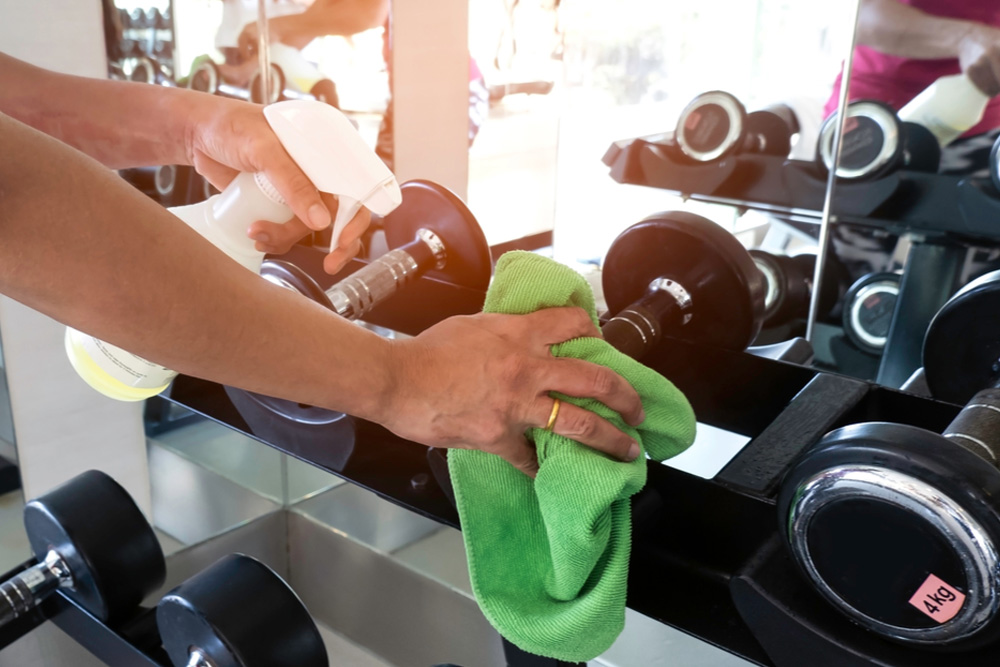
NEW INFO: Exercising with Caution – Requirements for Gym Openings In New Jersey
NOTE: The following are the most current guidelines and replace those mentioned in our September 2020 post.
On August 27, Governor Murphy issued Executive Order 181 (2020) (the “Order”), setting forth requirements for opening health clubs, as defined by N.J.S.A. 56:8-39, which includes gyms and fitness centers. Many questions remained as to whether the Order applied to community association gyms and fitness centers. On September 5, 2020, the Office of Emergency Management finally clarified, through Administrative Order No. 2020-21 (“AO”), that the Order did not apply to community associations so long as the fitness center is not opened to the public. In other words, provided the fitness center in your community association is only open to residents, guests and employees, the association need not comply with the Order.
For the reasons explained below, we still do not recommend that you open your gyms and fitness centers. If you decide to open, it is important for community associations across New Jersey to reach out to their legal counsel to review the procedures and protocols they need to put in place, as well as the liability that may flow from such opening and/or failure to adhere to the Order or the DOH guidelines. It is crucial that you have appropriate policies and guidelines for the use of your gym firmly established.
One important question the Order and AO cannot speak to is what does this mean in terms of legal liability if someone gets sick? If a resident sues, the association will defend by saying that the AO states the association was not subject to the Order and it was not required to comply. In response, the plaintiff will argue that the association still had a duty of care to protect the health and safety of its residents who used gym facilities in light of COVID-19. In other words, by opening the gym, the association implied it was safe to use. What, exactly, did the association do to ensure the safety of the residents using the gym? And, were the actions it took adequate?
For these reasons, if your community decides to open its gym or fitness center, we recommend that you adhere to requirements of the Order, especially with respect to:
- maximum occupancy;
- providing sanitizing wipes at every station;
- spacing gym equipment so six feet distancing can be maintained; and
- maintaining a sign-in sheet for contact tracing.
Even though the association isn’t subject to the Order, they still set a measuring stick for what constitutes reasonable action in the face of COVID-19. The association doesn’t lose its obligation to maintain its property in a manner safe for use by the residents. At a minimum, if an association is insistent on opening a gym facility, it should post signs in the gym that say:
- Each user must sign in at the sheet provided;
- No guests permitted, permanent residents only;
- After each use of equipment you must wipe down the equipment with the sanitizing wipes provided at each station;
- If you did not witness equipment being cleaned by prior user, you must clean it before and after use;
- You must wear a mask;
- You must remain distanced at least 6 feet from any other person in the gym unless that person is an immediately family member; and
- The maximum gym occupancy is “X.”
Even following all of the requirements of the Order, including having a monitor present, there is no guarantee that you will be immune or otherwise safe from legal liability should someone get sick. In addition, given the lack of insurance coverage for these types of claims, we do not recommend opening these facilities at this time. If you decide to open your gym, be sure to do so in consultation with counsel.
The following is an excerpt from our prior September 1, 2020 article detailing the lengthy requirements of the Order, any one of which a user of your gym or fitness center may point to as failing to adequately protect them if not complied with:
Pursuant to the Order, indoor gyms and fitness centers will be permitted to open on September 1, 2020, provided the facility complies with standards issued by the New Jersey Department of Health (“DOH”), including DOH’s August 27, 2020 Guidance for Health Clubs/Gyms/Fitness Centers.
General Requirements for Indoor Gym and Fitness Center Facilities:
- Limit occupancy of any indoor premises to 25 percent of the stated maximum capacity, if applicable, at one time, excluding staff.
- In addition to capacity restrictions, indoor group activities (e.g., classes) can occur but must limit to no more than 1 individual per 200 square feet of accessible space or less.
- Individuals must be able to maintain a minimum of 6-feet of distance from other individuals during the entire class.
- Conduct a temperature screening and questionnaire of staff and resident upon entrance to the facility each day.
- If individuals attending outdoor classes enter the center premises, whether to use a restroom or otherwise, they must be included in the capacity limit indicated above.
- Employees and residents must always wear cloth face coverings while in the indoor portion of the premises , except where doing so would inhibit that individual’s health or where the individual is under two years of age.
- If a resident refuses to wear a cloth face covering for non-medical reasons, and if such covering cannot be provided to the individual by the association at the point of entry, then the association must decline the individual entry into the indoor premises.
- One-on-one personal training can occur assuming 6-feet of distance can be maintained for most of the training session.
- Individual or pair activities which do not involve contact (e.g., racket ball, handball) may also occur.
- Keep doors and windows open where possible and utilize fans to improve ventilation.
- Inspect and evaluate the heating, ventilation and air conditioning (HVAC) unit to ensure that the system is operating within its design specifications.
- Shared saunas and steam rooms are not permitted.
According to the New Jersey DOH Guidance for Health Clubs/Gyms/Fitness Centers the following additional standards must be maintained if an indoor gym or fitness center is to be opened:
- Facilities must monitor each time a user enters and exits the gym, ensure social distancing procedures are being following, and limit occupancy at all times.o Facilities for which no permitted occupancy limit is on record may only allow 125 square feet per person of accessible indoor space.
- Signage must be placed at the gym’s entrances which instruct individuals that they cannot enter if they have been diagnosed with or suspected to have had COVID-19 and are still within the required isolation period as defined by the CDC, or if they have been in close contact with an individual diagnosed with COVID-19 as defined by the CDC.
- Waiting areas need to be closed or limited.
- For class-based activities with distinct session times, residents must be asked to either wait in their cars or outside until 10 minutes prior to their class
- For locker rooms, gym-goers should be informed to arrive dressed and ready to workout/train, bring their own towel, water, yoga mat, boxing gloves, and any other equipment.
- Locker room use will be limited to hand washing and restroom use only.
- Facility provided towel services should be discontinued.
- Individually partitioned showers or communal showers with installed barriers/partitions (at least 6-feet apart) are permitted in gyms with pools. Showers are otherwise not permitted for use.
- Facilities shall conduct temperature screenings and questionnaire of staff and residents upon their entrance to the gym. Anyone found to have a temperature of 100.4 or above, or who answers yes to any of the following or similar questions, shall be denied entrance to the facility:
- Within the last 10-days have you been diagnosed with COVID-19, had a test confirming you have the virus, or been advised to self-isolate or quarantine by your doctor or a public health official?
- Have you had any one or more of the following symptoms today or within the past 24-hours, which is not new or not explained by another reason?
- Fever, chills, cough, shortness of breath, sore throat, fatigue, headache, muscle/body aches, runny nose/congestion, new loss of taste or smell, or nausea, vomiting or diarrhea?
- In the past 14-days, have you had close contact as defined by the New Jersey Department of Health as:
- Being within approximately 6-feet of a COVID-19 case for a prolonged period of time (≥ 10 minutes); OR
- Direct contact with infectious secretions from a patient with COVID-19. Infectious secretions may include sputum, serum, blood, and respiratory droplets (e.g., being coughed or sneezed on).
- In the past 14-days, have you had close contact as defined by the New Jersey Department of Health as:
- Access must be limited to the gym through the front entrance. Other access points should be kept closed, except where required to remain open by law or where safety requires it.
- Physical partitions must be installed in areas where physical distancing is not possible, such as service counters. Contact-less sign-in methods are encouraged.
Social Distancing:
- Individuals must maintain 6-feet of distance from each other , to the greatest extent possible.
- Gyms must have a social distancing plan which explains where gym-goers can be at a given time in lobby, waiting areas, private offices, and the training area.
- Signage must be placed throughout the gym instructing individuals of the enhanced social distancing requirements (entrances, floors, etc.).
- Training equipment will be adjusted/access restricted in order to maintain proper social distancing standards.
- Equipment must be spaced out at least 6-feet apart. Installation of barriers between machines should be utilized where practicable.
- Training sessions must be staggered to maintain social distancing and limited capacity in facilities.
- Locker rooms should be closed or marked to enforce 6-feet social distancing. Lockers should be sanitized after each use.
- Gyms should provide sanitizing wipes near the lockers or in the locker room.
Cleanings:
- There must be access to handwashing on site, including soap and running water; alcohol-based hand sanitizers with at least 60 percent alcohol may be used as an alternative.
- Hand sanitizer and disposable wipes must be distributed abundantly throughout the space for employees and gym-goers to disinfect hands and equipment before and after use.
- Disposable wipes should be placed next to each piece of large & small equipment.
- Proper sanitizing procedures must be posted throughout the gym.
- Cleaning and disinfecting of high-touch surfaces (handrails, doorknobs, and restrooms) must be performed at least three-times a day.
- Trainers must wash hands before and after each training session and sanitize frequently during each session.
- All equipment must be sanitized between uses. Sanitization supplies must be provided at each piece of equipment so gym-goers can sanitize in between uses.
- Equipment must be sanitized before returning to a storage rack.
- 30-minute windows must be scheduled between classes to allow for thorough cleaning and appropriate cleaning and proper ventilation of the gyms, and to discourage congestion.
- Staff responsibility must be clearly designated for sanitization, cleaning, and supervision during shifts.
- Restrooms must be frequently cleaned during each shift and disinfected throughout the day
- If an employee or gym-goer tests positive for COVID-19, the gym must be shut down for a period of 24-hours before it is thoroughly cleaned and disinfected in accordance with current CDC guidelines.
- Cleaning logs that include date, time, and scope must be kept.
Staff Wellness & Safety:
- Associations must provide employees with face coverings/masks to wear while in the gym, at no cost to the employee.
- Break time and lunch time for employees must provide for enough time to wash hands and be staggered to ensure at least 6-feet of physical distance between employees.
- Personal trainers should maintain 6-feet of distance from their residents to the extent it is possible.
- Training must be provided to employees on up-to-date safety information and precautions, including the following:
- Social distancing, handwashing, proper use of face coverings;
- Self-screening at home, including temperature and symptom checks;
- Reinforcing that staff should not come to work if sick;
- When to seek medical attention if symptoms become severe;
- Which underlying health conditions may make individuals more susceptible contracting and suffering from a severe case of the virus.
- Employees must be screened at the beginning of each shift in the same manner as required for gym-goers.
- An association must notify the local health department (LHD) in the municipality where they are located and assist the LHD as reasonably requested if they learn of a positive COVID-19 diagnosis of an employee or a gym-going member.
Indoor Air/Ventilation:
- Heating, ventilation, and air conditioning (HVAC) units must be inspected and evaluated to ensure the systems are operational.
- Routine maintenance as recommended by the manufacturer or HVAC professional must be performed.
- Within the design specification of the HVAC unit:
- Increase the volume of outdoor air to the maximum capacity while the gym is occupied;
- Reduce the volume of recirculated air being returned to the indoor spaces;
- Increase the volume of air being delivered to the indoor spaces to the maximum capacity;
- Select maximum filtration levels for the HVAC unit;
- Ensure that the HVAC unit runs continuously while the gym is occupied;
- Ensure that the HVAC unit runs for at least two hours before and two hours after the gym is occupied.
- Associations must review and follow the latest CDC guidance for ventilation requirements.
Insurance professionals continue to advise that it is likely that the association general liability policies provide no coverage for claims emanating from COVID-19. Directors and Officers coverage has always excluded personal injury claims and are, therefore, unlikely to offer any coverage as well. Thus, there is an increased risk of liability if an association fails to strictly adhere to these requirements. All boards should keep this in mind when deciding whether it is prudent to open association gyms, fitness centers or similar facilities.






